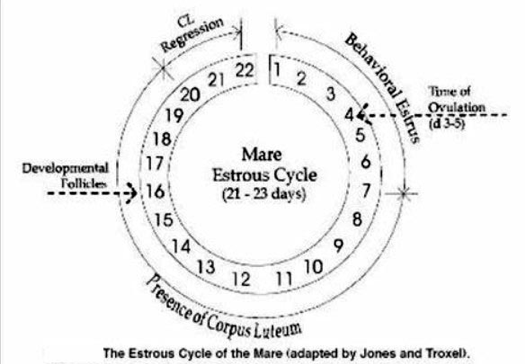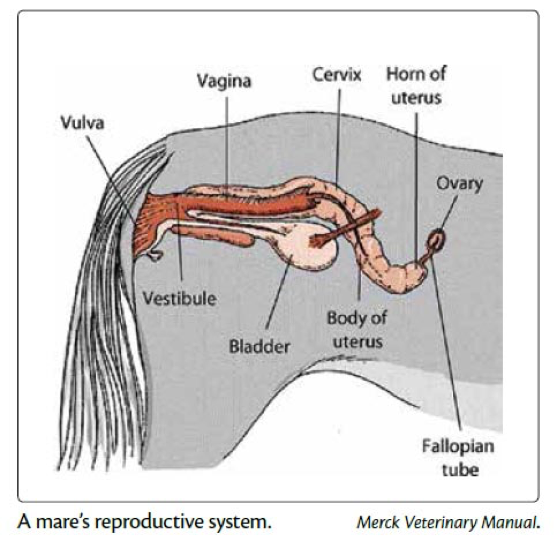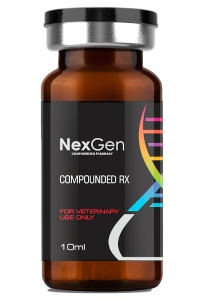Understanding the Mare's Heat Cycle Chart

A working knowledge of the mare’s reproductive anatomy and physiology is essential in a horse breeding program. Familiarity with the mare's estrous cycle and the timing of events therein is equally important. These provide the basis on which all other principles of horse breeding rest.
Horse owners and managers choose to breed mares for a variety of reasons. Some are owners who have a beloved mare from which a foal is wanted, while others manage a large-scale breeding operation as a business. Many others may fall in between this spectrum.1 Regardless of the reason for choosing to be involved in horse breeding, a working knowledge of the mare’s reproductive system, as well as its particulars and peculiarities is paramount.

Terminology
The mare is seasonally polyestrus, meaning that she undergoes regular estrus cycles during late Spring, Summer and early Fall and none during the Winter. This is nature's way of preventing the arrival of a foal during the harsh Winter weather.
Common terminology pertaining to the mare's estrous cycle is as follows:
- Estrous (œstrous in many parts of the world outside North America) refers to the entire cycle.
- Estrus (œstrus) refers to the "heat" stage of that cycle when the mare is receptive to the stallion's advances.
- Diestrus (diœstrus) refers to the period in between the estrus phases when the mare is not receptive to the stallion.
- Anestrus (anœstrus) refers to the complete absence of estrus.2
The mare’s normal cycling period is from approximately March through September. During this period, the mare undergoes a series of cycles, each approximately 22 days in length. The estrous cycle is divided into two physiological parts: estrus and diestrus.3
The estrus, or "heat" segment of the cycle, is three to seven days in length and is the time when a mare is receptive to the stallion. Estrus must be accurately determined because it is the period during which the mare must be bred in order to conceive. Ovulation (release of the egg for fertilization) usually occurs 24 to 48 hours before the end of estrus. Conception rates are highest when the mare is bred 36 hours before and up to ovulation.3
Anatomy and Physiology
The mare’s reproductive tract lies in a horizontal position within the abdominal and pelvic cavities. It includes the vulva, vagina, cervix, uterus, oviducts and ovaries. Changes in the anatomy or interruption in the function of any section can contribute to reproductive problems.

The vulva is the exterior opening to the reproductive canal. It consists of the labia, clitoris and the vestibule. The construction of this region is important because it serves to protect the mare from the entrance of air and other contaminants into the vaginal vault.2
The vagina consists of a six to eight-inch long muscular mucus membrane-lined tube which connects the vestibule of the vulva to the cervix. The vaginal tissues are extremely elastic in order to accommodate the penis during breeding and the foal during birth.
The cervix is approximately four inches long and appears as a circle of folded tissue at the anterior surface of the vaginal vault.2 The shape and tone of the cervix change dramatically in response to hormonal changes in the mare during her cycle.
The uterus is a multi-layered, hollow, Y-shaped organ. The base of the Y is called the uterine body, while the two branches are called the horns.2 The uterus is composed of three distinct layers; the outer layer, the myometrium, and the endometrium.
Also known as the Fallopian tubes, the oviducts are small, highly coiled tubes. Each connects the tip of a uterine horn with an ovary. The ovarian end of the oviduct is called the infundibulum.2
The ovary is a kidney bean-shaped organ; the mare possesses two of these, located at each terminal end of the oviducts (infundibulum). "During the breeding season they are functioning and about the size of a tennis ball. The convex side of the ovary is called the hilus and is the area of attachment to the abdominal cavity."2 It is within the ovaries that follicles form, and it is from within the follicles that mature ova are released into the oviducts during estrus.
Hormonal Activity
During the nonreproductive season of winter, most mares are in a state of reproductive quiescence (hibernation) called anestrus. During this time, they will not respond to the stallion’s attention, their ovaries do not develop any structures and there is minimal ovarian hormone secretion. The situation changes dramatically during spring and summer. As daylight hours increase, ovarian hormonal secretions also increase. The mare will begin to experience a series of estrous cycles.1
It is important to understand that there is a closely linked feedback system between many of the reproductive hormones present in the mare which will alter the level or presence of some hormones as levels of other different hormones increase or decrease.2
Gonadotropin Releasing Hormone (GnRH) - this hormone is secreted by the hypothalamus of the brain and governs the activities of other reproductive hormones. "Early in the year stimulation of the pineal gland by light - either natural or artificial - causes a reduction of melatonin secretion, which in turn allows GnRH to be secreted by the hypothalamus, thereby stimulating the production of other hormones."2
Follicle stimulating hormone (FSH) and Luteinizing hormone (LH) - These two hormones are gonadotropins that are produced in the pituitary gland and are regulated in a similar manner by GnRH.
Estrogen - Several forms of estrogen occur in the mare during her cycle. "In the non-pregnant mare estradiol is the most active; in the pregnant mare there are several, but the most important to note is estrone sulphate. Estradiol in the estrus mare is secreted by the follicle and serves several purposes. Its presence is associated with the behavioral displays common to estrus. Estradiol also causes the relaxation of the cervix during estrus.

Progesterone - This hormone prevents the display of estrus in non-pregnant mares and is also partly responsible for increasing uterine and cervical tone in the diestrus mare. Progesterone is secreted by the corpus luteum (CL) that is formed in the evacuated follicle left behind after the mare has ovulated.2
Prostaglandin is involved in the activity of the corpus luteum and the uterus. Secretion of Prostaglandin F2α by the lining of the uterus commences if pregnancy is not detected at about day 14 post-ovulation,2 and causes contraction of the uterus.
Inhibin is a follicular hormone that in addition to estrogen mitigates the impact that progesterone has on FSH follicular maturation and selection.2
During the nonreproductive season (Winter), most mares are in a state of reproductive quiescence (hibernation) called anestrus. During this time, they will not respond to the stallion’s attention, their ovaries do not develop any structures and there is minimal ovarian hormone secretion.1 As daylight hours increase, ovarian hormonal secretions also increase. The mare will again begin to experience estrous cycles until pregnancy occurs or until the days again shorten and she reverts back anestrus.
1extension.org.
2equine-reproduction.com.
3extension.org.
 Equine Breeding Products
Equine Breeding Products
You can find equine breeding products in our online store. Login to your account to view prices and purchase or create an account. Please note you must have a valid veterinarian license to create an account. If you do not, please forward our information to your veterinarian.
About NexGen Pharmaceuticals
NexGen Pharmaceuticals is an industry-leading veterinary compounding pharmacy, offering sterile and non-sterile compounding services nationwide. Unlike other veterinary compounding pharmacies, NexGen focuses on drugs that are difficult to find or are no longer available due to manufacturer discontinuance or have yet to be offered commercially for veterinary applications, but which still serve a critical need for our customers. We also specialize in wildlife pharmaceuticals, including sedatives and their antagonists, offering many unique options to serve a wide array of zoo animal and wildlife immobilization and anesthesia requirements.
Our pharmacists are also encouraged to develop strong working relationships with our veterinarians in order to better care for veterinary patients. Such relationships foster an ever-increasing knowledge base upon which pharmacists and veterinarians can draw, making both significantly more effective in their professional roles.
Disclaimer
The information contained in this blog post is general in nature and is intended for use as an informational aid. It does not cover all possible uses, actions, precautions, side effects, or interactions of the medications shown, nor is the information intended as medical advice or diagnosis for individual health problems or for making an evaluation as to the risks and benefits of using a particular medication. You should consult your veterinarian about diagnosis and treatment of any health problems. Information and statements have not been evaluated by the Food and Drug Administration ("FDA"), nor has the FDA approved the medications to diagnose, cure or prevent disease. Medications compounded by NexGen Pharmaceuticals are prepared at the direction of a veterinarian. NexGen Pharmaceuticals compounded veterinary preparations are not intended for use in food and food-producing animals.
NexGen Pharmaceuticals, LLC does not recommend, endorse or make any representation about the efficacy, appropriateness or suitability of any specific dosing, products, procedures, treatments, services, opinions, veterinary care providers or other information that may be contained in this blog post. NEXGEN PHARMACEUTICALS, LLC IS NOT RESPONSIBLE NOR LIABLE FOR ANY ADVICE, COURSE OF TREATMENT, DIAGNOSIS OR ANY OTHER INFORMATION, SERVICES OR PRODUCTS THAT YOU OBTAIN THROUGH THIS BLOG POST.



